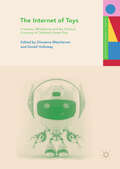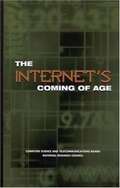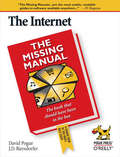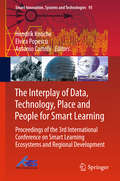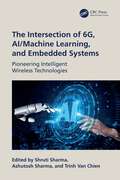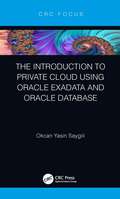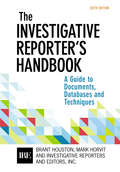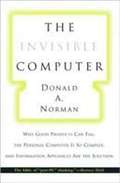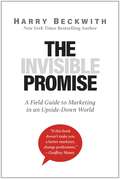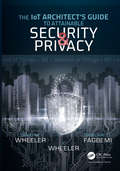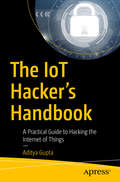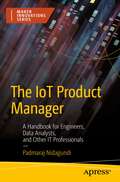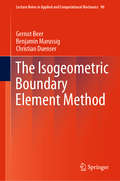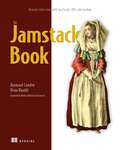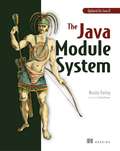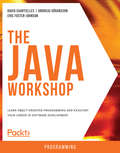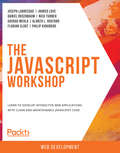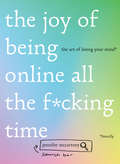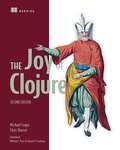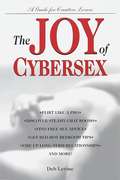- Table View
- List View
The Internet of Toys: Practices, Affordances and the Political Economy of Children’s Smart Play (Studies in Childhood and Youth)
by Giovanna Mascheroni Donell HollowayThe Internet of Toys (IoToys) is a developing market within our Internet of Things (IoT) ecosystem. This book examines the rise of internet-connected toys and aims to anticipate the opportunities and risks of IoToys before their widespread diffusion. Contributors to this volume each provide a critical analysis of the design, production, regulation, representation and consumption of internet-connected toys. In order to address the theoretical, methodological and policy questions that arise from the study of these new playthings, and contextualise the diverse opportunities and challenges that IoToys pose to educators, families and children themselves, the chapters engage with notions of mediatization, datafication, robotification, connected and post-digital play. This timely engagement with a key transformation in children’s play will appeal to all readers interested in understanding the social uses and consequences of IoToys, and primarily to researchers and students in children and media, early childhood studies, media and communications, sociology, education, social psychology, law and design.
The Internet's Coming Of Age
by National Research Council Compature Science Telecommunications BoardWhat most of us know as "the Internet" is actually a set of largely autonomous, loosely coordinated communication networks. As the influence of the Internet continues to grow, understanding its real nature is imperative to acting on a wide range of policy issues.This timely new book explains basic design choices that underlie the Internet's success, identifies key trends in the evolution of the Internet, evaluates current and prospective technical, operational, and management challenges, and explores the resulting implications for decision makers. The committee-composed of distinguished leaders from both the corporate and academic community-makes recommendations aimed at policy makers, industry, and researchers, going on to discuss a variety of issues: How the Internet's constituent parts are interlinked, and how economic and technical factors make maintaining the Internet's seamless appearance complicated. How the Internet faces scaling challenges as it grows to meet the demands of users in the future. Tensions inherent between open innovation on the Internet and the ability of innovators to capture the commercial value of their breakthroughs. Regulatory issues posed by the Internet's entry into other sectors, such as telephony.
The Internet: Getting Connected (Fountas and Pinnell Benchmark Assessment System 2 #Level X, Nonfiction)
by George CapaccioThe Internet: Getting Connected by George Capaccio
The Internet: The Missing Manual (Missing Manual)
by David Pogue J. D. BiersdorferThe Internet is almost synonymous with change--that's one of its charms, and one of its headaches. You may think you know the Internet, but are you really up to speed on internet telephones, movie and TV downloading, blogging, gaming, online banking, dating, and photosharing? This utterly current book covers:Getting Online. Readers will have all the information they need to decide what kind of broadband connection works best for them, which browser they should use, and what kind of spyware-fighting and virus-and spam-protection measures they need to protect themselves.Finding Information. Google may be the leading search site, but it's certainly not the only game in town. This book introduces a diverse and useful collection of sites that help uncover everything from health care information, to shopping, travel and finance, to dependable reviews and ratings.Movies, music, and photos. The Web's teeming with entertainment--and not just the sort of postage-stamp sized videos that only a geek could love. Learn where to download movies, watch TV online, listen to music, play games, and post and share photos with friends.Keeping in touch. Email's only the beginning. This book introduces readers to the many tools that make the modern Internet such a great way to stay connected. From Web-based discussion groups to instant messaging programs, and from blogs and podcasts to Internet-based phone calls, this book will help you join the conversation.Ideal for anyone just venturing into cyberspace, this book is also perfect for more experienced users who could use an update to today's most exciting internet applications.
The Interplay of Data, Technology, Place and People for Smart Learning: Proceedings Of The 3rd International Conference On Smart Learning Ecosystems And Regional Development (Smart Innovation, Systems And Technologies #95)
by Elvira Popescu Hendrik Knoche Antonio CartelliThis book gathers contributions to the 3rd International Conference on Smart Learning Ecosystems and Regional Developments (SLERD 2018), held at Aalborg University, Denmark on 23–25 May 2018. What characterizes smart learning ecosystems? What is their role in city and regional development and innovation? How can we promote citizen engagement in smart learning ecosystems? These are some of the questions addressed at SLERD 2018 and documented in these proceedings, which include a diverse range of papers intended to help understand, conceive, and promote innovative human-centric design and development methods, education/training practices, informal social learning, and citizen-driven policies. The papers elaborate on the notion of smart learning ecosystems, assess the relation of smart learning ecosystems with their physical surroundings, and identify new resources for smart learning. SLERD 2018 contributes to foster the social innovation sectors, ICT and economic development and deployment strategies, as well as new policies for smarter, more proactive citizens. As such, these proceedings are relevant for researchers and policymakers alike.
The Intersection of 6G, AI/Machine Learning, and Embedded Systems: Pioneering Intelligent Wireless Technologies
by Ashutosh Sharma Shruti Sharma Trinh Van ChienThis comprehensive guide to the emerging areas and synergistic relationships among the domains of 6G, machine learning, and embedded systems offers readers a detailed analysis of their converging paths and contributions to the development of intelligent wireless systems. Readers will gain a solid understanding of the principles and technologies behind 6G, machine learning, and embedded systems. They will learn how these three areas intertwine and why this intersection is pivotal for the next generation of wireless technologies.The contributors to this volume present a thorough and detailed analysis of this technology, highlighting its promising features, underlying technologies, and potential applications. The book first explores various applications of machine learning algorithms in areas such as network optimization, resource allocation, interference management, and intelligent data processing and analysis. Design considerations and challenges are presented, and case studies of innovative applications, such as smart cities, autonomous vehicles, healthcare, and industrial automation, are examined. The book concludes with a discussion of future trends and opportunities in this rapidly evolving field. Readers will benefit from the theoretical foundations and practical insights presented within and will be prepared to address future challenges and opportunities in these three fields.This book is a valuable resource for academic researchers and industry professionals working in the fields of wireless communication, machine learning, embedded systems, and artificial intelligence.
The Intimate Life of Computers: Digitizing Domesticity in the 1980s
by Reem HiluA feminist perspective on the early history of personal computing, revealing how computers were integrated into the most intimate aspects of family life The Intimate Life of Computers shows how the widespread introduction of home computers in the 1980s was purposefully geared toward helping sustain heteronormative middle-class families by shaping relationships between users. Moving beyond the story of male-dominated computer culture, this book emphasizes the neglected history of the influence of women&’s culture and feminist critique on the development of personal computing despite women&’s underrepresentation in the industry. Proposing the notion of &“companionate computing,&” Reem Hilu reimagines the spread of computers into American homes as the history of an interpersonal, romantic, and familial medium. She details the integration of computing into family relationships—from helping couples have better sex and offering thoughtful simulations of masculine seduction to animating cute robot companions and giving voice to dolls that could talk to lonely children—underscoring how these computer applications directly responded to the companionate needs of their users as a way to ease growing pressures on home life. The Intimate Life of Computers is a vital contribution to feminist media history, highlighting how the emergence of personal computing dovetailed with changing gender roles and other social and cultural shifts. Eschewing the emphasis on technologies and institutions typically foregrounded in personal-computer histories, Hilu uncovers the surprising ways that domesticity and family life guided the earlier stages of our all-pervasive digital culture.
The Introduction to Private Cloud using Oracle Exadata and Oracle Database
by Okcan Yasin SaygiliPrivate clouds allow for managing multiple databases under one roof, avoiding unnecessary resource management. Private cloud solutions can be applied in sectors such as healthcare, retail, and software. The Introduction to Private Cloud using Oracle Exadata and Oracle Database will explore the general architecture of private cloud databases with a focus on Oracle’s Exadata database machine. The book describes the private cloud using fundamental-level Exadata and database. Exadata has been Oracle’s pioneer product for almost a decade. In the last few years, Oracle has positioned Exadata for customers to consume as a cloud service. This book will provide a timely introduction to Exadata for current and potential Oracle customers and other IT professionals.
The Investigative Reporter’s Handbook: A Guide To Documents, Databases, And Techniques
by Brant Houston Mark Horvit Investigative Reporters Inc. EditorsBuild the fundamental investigative writing and reporting skills you need to investigate anything and anyone. The text’s easy-to-use handbook style allows readers to quickly access any information--everything from how to build quality reporting skills and collaborate on investigations to tips for researching a variety of beats. This is the text on investigative reporting, infused with illustrative quotes and instructive examples from highly-respected journalists around the world.
The Invisible Computer: Why Good Products Can Fail, the Personal Computer Is So Complex, and Information Appliances Are the Solution
by Donald A. NormanTechnologies have a life cycle, says Donald A. Norman, and they must change as they pass from youth to maturity. Alas, the computer industry thinks it is still in its rebellious teenage years, exalting in technical complexity.
The Invisible Promise: A Field Guide to Marketing in an Upside-Down World
by Harry BeckwithOur service economy is dominated by outmoded marketing models from the world of products. The Invisible Promise reveals the critical differences between service and product marketing and outlines a service-centric strategy for planning your business, persuading your prospects, and relating to your clients. Unlike products, you can&’t see, touch, or feel services. Marketing services requires an approach that doesn&’t rely on the traditional 4 Ps of product marketing: product, price, place, and promotion. Selling invisible services requires making the promise of their yet-unseen value resonate with prospective clients. In The Invisible Promise, Harry Beckwith, New York Times bestselling author of Selling the Invisible, applies his 40-plus years of advising businesses around the world and his research in the last 10 years to impart the proven guidance that businesses of all sizes desperately need. In this new age in marketing, he details how to build messages that enhance your reputation for integrity, stand out from the clutter, and can produce exponential growth while saving you both time and money. If you are responsible for marketing a service, the tried-and-true strategies for product marketing simply will not fit. You need to alter your approach radically. That&’s where The Invisible Promise comes in.
The IoT Architect's Guide to Attainable Security and Privacy
by Damilare D. Fagbemi David M Wheeler JC WheelerThis book describes how to architect and design Internet of Things (loT) solutions that provide end-to-end security and privacy at scale. It is unique in its detailed coverage of threat analysis, protocol analysis, secure design principles, intelligent loT's impact on privacy, and the effect of usability on security. The book also unveils the impact of digital currency and the dark web on the loT-security economy. It's both informative and entertaining. "Filled with practical and relevant examples based on years of experience ... with lively discussions and storytelling related to loT security design flaws and architectural issues."— Dr. James F. Ransome, Senior Director of Security Development Lifecycle (SOL) Engineering, Intel 'There is an absolute treasure trove of information within this book that will benefit anyone, not just the engineering community. This book has earned a permanent spot on my office bookshelf."— Erv Comer, Fellow of Engineering, Office of Chief Architect Zebra Technologies 'The importance of this work goes well beyond the engineer and architect. The IoT Architect's Guide to Attainable Security & Privacy is a crucial resource for every executive who delivers connected products to the market or uses connected products to run their business."— Kurt Lee, VP Sales and Strategic Alliances at PWNIE Express "If we collectively fail to follow the advice described here regarding loT security and Privacy, we will continue to add to our mounting pile of exploitable computing devices. The attackers are having a field day. Read this book, now."— Brook S.E. Schoenfield, Director of Advisory Services at IOActive, previously Master Security Architect at McAfee, and author of Securing Systems
The IoT Hacker's Handbook: A Practical Guide to Hacking the Internet of Things
by Aditya GuptaTake a practioner’s approach in analyzing the Internet of Things (IoT) devices and the security issues facing an IoT architecture. You’ll review the architecture's central components, from hardware communication interfaces, such as UARTand SPI, to radio protocols, such as BLE or ZigBee. You'll also learn to assess a device physically by opening it, looking at the PCB, and identifying the chipsets and interfaces. You'll then use that information to gain entry to the device or to perform other actions, such as dumping encryption keys and firmware. As the IoT rises to one of the most popular tech trends, manufactures need to take necessary steps to secure devices and protect them from attackers. The IoT Hacker's Handbook breaks down the Internet of Things, exploits it, and reveals how these devices can be built securely.What You’ll LearnPerform a threat model of a real-world IoT device and locate all possible attacker entry points Use reverse engineering of firmware binaries to identify security issues Analyze,assess, and identify security issues in exploited ARM and MIPS based binariesSniff, capture, and exploit radio communication protocols, such as Bluetooth Low Energy (BLE), and ZigBeeWho This Book is ForThose interested in learning about IoT security, such as pentesters working in different domains, embedded device developers, or IT people wanting to move to an Internet of Things security role.
The IoT Product Manager: A Handbook for Engineers, Data Analysts, and Other IT Professionals
by Padmaraj NidagundiEnhance your product management skills and set yourself apart from other product managers working in the IoT industry. This book shows you how to navigate through the world of small and Edge devices to successfully launch and monitor products connected together to make smart environments.Working in Agile environments, you'll learn to guide UI builds that serve customer needs and function the way top tech companies expect. Then measure the right product metrics and create reporting dashboards for your IoT products. That way you can effectively engage partners, engineers, and stakeholders. And you’ll learn the entire end-to-end development process of IoT products so that you can make sure you make the right moves at the right stages. After mastering the IoT product lifecycle and measuring your success against KPIs, you’ll see how to work with marketing to effectively launch your product in the marketplace. Finally, a self-interview section has been provided so that you can evaluate your skills and responses to common IoT Product Manager questions. Then take what you've learned and go out into the world to develop integrated IoT products that your customers love!What You'll LearnCreate UI/UX experiences that engage and wow your customersWork in Agile environments with best business practicesNegotiate effectively at each step of the product lifecycleWho This Book Is ForAny wanting to build a IoT products. Aspiring Internet of Things product managers, product owners, analysts, business consultants, engineers, and business owners.
The Isogeometric Boundary Element Method (Lecture Notes in Applied and Computational Mechanics #90)
by Gernot Beer Benjamin Marussig Christian DuenserThis book discusses the introduction of isogeometric technology to the boundary element method (BEM) in order to establish an improved link between simulation and computer aided design (CAD) that does not require mesh generation. In the isogeometric BEM, non-uniform rational B-splines replace the Lagrange polynomials used in conventional BEM. This may seem a trivial exercise, but if implemented rigorously, it has profound implications for the programming, resulting in software that is extremely user friendly and efficient. The BEM is ideally suited for linking with CAD, as both rely on the definition of objects by boundary representation. The book shows how the isogeometric philosophy can be implemented and how its benefits can be maximised with a minimum of user effort. Using several examples, ranging from potential problems to elasticity, it demonstrates that the isogeometric approach results in a drastic reduction in the number of unknowns and an increase in the quality of the results. In some cases even exact solutions without refinement are possible. The book also presents a number of practical applications, demonstrating that the development is not only of academic interest. It then elegantly addresses heterogeneous and non-linear problems using isogeometric concepts, and tests them on several examples, including a severely non-linear problem in viscous flow. The book makes a significant contribution towards a seamless integration of CAD and simulation, which eliminates the need for tedious mesh generation and provides high-quality results with minimum user intervention and computing.
The Jamstack Book: Beyond static sites with JavaScript, APIs, and markup
by Raymond Camden Brian RinaldiJamstack = JavaScript, APIs, and Markup. Use established standard technologies to build super-fast static websites without sacrificing rich, dynamic features.In The Jamstack Book, you will learn how to: Use different static site generators to build websites Deploy Jamstack sites with 11ty, Next.js, Hugo, and Jekyll Add dynamic capabilities like form processing and eCommerce Enhance your Jamstack site with serverless capabilities Integrate a CMS with a Jamstack site Jamstack sites use JavaScript, APIs, and Markup to create fast, dynamic pages without the overhead of heavyweight frameworks. The Jamstack Book is your essential guide to this exciting new web architecture. Written by renowned Jamstack experts Raymond Camden and Brian Rinaldi, it&’s filled with real-world projects to develop and hone your skills. You&’ll learn how to lay out and generate a site, set up your own CMS, and add dynamic features like user logins and search functionality. Confusing jargon is demystified. Plus, you&’ll get the chance to try out different static site generators and find the one that works best for you. Pick up this book today, and you&’ll discover how the Jamstack answers your need for speed and simplicity. About the technology JavaScript, APIs, and pre-rendered Markup put the JAM in Jamstack. This modern web architecture delivers the quick load times of static sites along with the dynamic functionality you need for user-friendly interactive features. Built with lightweight standards and tools, Jamstack sites are fast, secure, easy to maintain, and naturally optimized for mobile and SEO. About the book The Jamstack Book teaches effectively by creating a portfolio of sites, ranging from a simple blog to an eCommerce store. Each new project introduces important skills, including cloud deployment, user logins, and search. You&’ll get hands-on experience with tools like 11ty, Next.js, and Netlify. As your skills grow, the examples become more sophisticated, including serverless technology, dynamic forms, and an integrated CMS. What's inside Use different static site generators to build websites Add dynamic capabilities like form processing and eCommerce Enhance your Jamstack site with serverless capabilities Integrate a CMS with a Jamstack site About the reader For web developers and CMS site developers. About the author Raymond Camden is the author of multiple books on web development and has been blogging and presenting for almost twenty years. Brian Rinaldi has been involved in static site and Jamstack development since the early days. Table of Contents 1 Why Jamstack? 2 Building a basic Jamstack site 3 Building a blog 4 Building a documentation site 5 Building an e-commerce site 6 Deployment 7 Adding dynamic elements 8 Working with serverless computing 9 Adding a content management system 10 Migrating to the Jamstack
The Java Module System
by Nicolai ParlogSummaryJava's much-awaited "Project Jigsaw" is finally here! Java 11 includes a built-in modularity framework, and The Java Module System is your guide to discovering it. In this new book, you'll learn how the module system improves reliability and maintainability, and how it can be used to reduce tight coupling of system components.Foreword by Kevlin Henney.Purchase of the print book includes a free eBook in PDF, Kindle, and ePub formats from Manning Publications. You'll find registration instructions inside the print book.About the TechnologyPackaging code into neat, well-defined units makes it easier to deliver safe and reliable applications. The Java Platform Module System is a language standard for creating these units. With modules, you can closely control how JARs interact and easily identify any missing dependencies at startup. This shift in design is so fundamental that starting with Java 9, all core Java APIs are distributed as modules, and libraries, frameworks, and applications will benefit from doing the same.About the BookThe Java Module System is your in-depth guide to creating and using Java modules. With detailed examples and easy-to-understand diagrams, you'll learn the anatomy of a modular Java application. Along the way, you'll master best practices for designing with modules, debugging your modular app, and deploying to production.What's insideThe anatomy of a modular Java appBuilding modules from source to JARMigrating to modular JavaDecoupling dependencies and refining APIsHandling reflection and versioningCustomizing runtime imagesUpdated for Java 11About the ReaderPerfect for developers with some Java experience.About the AuthorNicolai Parlog is a developer, author, speaker, and trainer. His home is codefx.org. Table of ContentsPART 1 - Hello, modulesFirst piece of the puzzleAnatomy of a modular applicationDefining modules and their propertiesBuilding modules from source to JARRunning and debugging modular applicationsPART 2 - Adapting real-world projectsCompatibility challenges when moving to Java 9 or laterRecurring challenges when running on Java 9 or laterIncremental modularization of existing projectsMigration and modularization strategiesPART 3 - Advanced module system featuresUsing services to decouple modulesRefining dependencies and APIsReflection in a modular worldModule versions: What's possible and what's notCustomizing runtime images with jlinkPutting the pieces together
The Java Workshop: A Practical, No-Nonsense Introduction to Java Development
by Eric Foster-Johnson Andreas Goransson David CuartiellesCut through the noise and get real results with a step-by-step approach to learning Java programming Key Features Ideal for the Java beginner who is getting started for the first time A step-by-step Java tutorial with exercises and activities that help build key skills Structured to let you progress at your own pace, on your own terms Use your physical copy to redeem free access to the online interactive edition Book Description You already know you want to learn Java, and a smarter way to learn Java 12 is to learn by doing. The Java Workshop focuses on building up your practical skills so that you can develop high-performance Java applications that work flawlessly within the JVM across web, mobile and desktop. You'll learn from real examples that lead to real results. Throughout The Java Workshop, you'll take an engaging step-by-step approach to understanding Java. You won't have to sit through any unnecessary theory. If you're short on time you can jump into a single exercise each day or spend an entire weekend learning about Reactive programming and Unit testing. It's your choice. Learning on your terms, you'll build up and reinforce key skills in a way that feels rewarding. Every physical copy of The Java Workshop unlocks access to the interactive edition. With videos detailing all exercises and activities, you'll always have a guided solution. You can also benchmark yourself against assessments, track progress, and receive free content updates. You'll even earn a secure credential that you can share and verify online upon completion. It's a premium learning experience that's included with your printed copy. To redeem, follow the instructions located at the start of your Java book. Fast-paced and direct, The Java Workshop is the ideal companion for Java beginners. You'll build and iterate on your code like a software developer, learning along the way. This process means that you'll find that your new skills stick, embedded as best practice. A solid foundation for the years ahead. What you will learn Get to grips with fundamental concepts and conventions of Java 12 Write clean and well-commented code that's easy to maintain Debug and compile logical errors and handle exceptions in your programs Understand how to work with Java APIs and Java streams Learn how to use third-party libraries and software development kits (SDKs) Discover how you can work with information stored in databases Understand how you can keep data secure with cryptography and encryption Learn how to keep your development process bug-free with unit testing in Java Who this book is for Our goal at Packt is to help you be successful, in whatever it is you choose to do. The Java Workshop is an ideal Java tutorial for the Java beginner who is just getting started. Pick up a Workshop today, and let Packt help you develop skills that stick with you for life.
The JavaScript Workshop: A New, Interactive Approach to Learning JavaScript
by Joseph Labrecque Nick Turner Jahred Love Daniel Rosenbaum Gaurav MehlaFlorian
The Jazz Theory Book
by Mark Levine Sher MusicThe most highly-acclaimed jazz theory book ever published! Over 500 pages of comprehensive, but easy to understand text covering every aspect of how jazz is constructed---chord construction, II-V-I progressions, scale theory, chord/scale relationships, the blues, reharmonization, and much more. A required text in universities world-wide, translated into five languages, endorsed by Jamey Aebersold, James Moody, Dave Liebman, etc.
The Journalist's Predicament: Difficult Choices in a Declining Profession
by Matthew Powers Sandra Vera-ZambranoLow pay. Uncertain work prospects. Diminished prestige. Why would anyone still want be a journalist? Drawing on in-depth interviews in France and the United States, Matthew Powers and Sandra Vera-Zambrano explore the ways individuals come to believe that journalism is a worthy pursuit—and how that conviction is managed and sometimes dissolves amid the profession’s ongoing upheavals.For many people, journalism represents a job that is interesting and substantial, with opportunities for expression, a sense of self-fulfillment, and a connection to broader social values. By distilling complex ideas, holding the powerful to account, and revealing hidden realities, journalists play a crucial role in helping audiences make sense of the world. Experiences in the profession, though, are often far more disappointing. Many find themselves doing tasks that bear little relation to what attracted them initially or are frustrated by institutions privileging what sells over what informs. The imbalance between the profession’s economic woes and its social importance threatens to erode individuals’ beliefs that journalism remains a worthwhile pursuit. Powers and Vera-Zambrano emphasize that, as with many seemingly individual choices, social factors—class, gender, education, and race—shape how journalists make sense of their profession and whether or not they remain in it.An in-depth story of one profession under pressure, The Journalist’s Predicament uncovers tensions that also confront other socially important jobs like teaching, nursing, and caretaking.
The Joy of Being Online All the F*cking Time (Literally): The Art Of Losing Your Mind (literally)
by Jennifer McCartneyFrom the author of The Joy of Leaving Your Sh*t All Over the Place, comes a defense of screen time. We’re inundated with advice on how to cut back on our screen time, and urged instead to embrace nature, human relationships, and being present in the moment. But has anyone actually considered those realities? They sound like a lot of work. In her new book, Jennifer McCartney gives thanks for phones, iPads, laptops, the menu tablets at Chili’s, and all screens everywhere. We can now follow a baby alpaca on a webcam, watch a viral video on TikTok, find an ex on Facebook, measure our pupillary distances, answer any question without engaging our brains—there’s so much to learn, with little to no effort. The Internet practically runs itself! We use it for work, for family, for research. We’re really, really good at being online! And that’s something to celebrate. With her usual balance of pithy wisdom, aptitude tests, and hilarious commentary, McCartney embraces our new reality. After all, as Descartes might have said, “I scroll, therefore I am.”
The Joy of Clojure
by Michael Fogus Chris HouserSummaryThe Joy of Clojure, Second Edition is a deep look at the Clojure language. Fully updated for Clojure 1.6, this new edition goes beyond just syntax to show you the "why" of Clojure and how to write fluent Clojure code. You'll learn functional and declarative approaches to programming and will master the techniques that make Clojure so elegant and efficient.Purchase of the print book includes a free eBook in PDF, Kindle, and ePub formats from Manning Publications.About the TechnologyThe Clojure programming language is a dialect of Lisp that runs on the Java Virtual Machine and JavaScript runtimes. It is a functional programming language that offers great performance, expressive power, and stability by design. It gives you built-in concurrency and the predictable precision of immutable and persistent data structures. And it's really, really fast. The instant you see long blocks of Java or Ruby dissolve into a few lines of Clojure, you'll know why the authors of this book call it a "joyful language." It's no wonder that enterprises like Staples are betting their infrastructure on Clojure.About the BookThe Joy of Clojure, Second Edition is a deep account of the Clojure language. Fully updated for Clojure 1.6, this new edition goes beyond the syntax to show you how to write fluent Clojure code. You'll learn functional and declarative approaches to programming and will master techniques that make Clojure elegant and efficient. The book shows you how to solve hard problems related to concurrency, interoperability, and performance, and how great it can be to think in the Clojure way.Appropriate for readers with some experience using Clojure or common Lisp.What's InsideBuild web apps using ClojureScriptMaster functional programming techniquesSimplify concurrencyCovers Clojure 1.6About the AuthorsMichael Fogus and Chris Houser are contributors to the Clojure and ClojureScript programming languages and the authors of various Clojure libraries and language features.Table of ContentsPART 1 FOUNDATIONSClojure philosophyDrinking from the Clojure fire hoseDipping your toes in the poolPART 2 DATA TYPESOn scalarsCollection typesPART 3 FUNCTIONAL PROGRAMMINGBeing lazy and set in your waysFunctional programmingPART 4 LARGE-SCALE DESIGNMacrosCombining data and codeMutation and concurrencyParallelismPART 5 HOST SYMBIOSISJava.nextWhy ClojureScript?PART 6 TANGENTIAL CONSIDERATIONSData-oriented programmingPerformanceThinking programsClojure changes the way you think
The Joy of Cybersex: A Creative Guide for Lovers
by Deborah LevineTHE JOY OF CYBERSEXA Guide for Creative Lovers--Learn to Flirt like a Pro--Find Steamy Chat Rooms--Get Sex and Relationship Counseling--Fuel Hot Monogamy--Go Beyond the Picket Fence--And more!What is the word searched most often on the Internet?You've got it--SEX.But where do you go? What's safe? What do you do when you get there? In this fun, informative, and thoroughly satisfying book, on-line sexpert Deb Levine guides you to all the right sites so you can --Pack up the "come here often"--lines and learn to flirt like a pro--Meet your soul mate--or at least a decent date--Get answers to all those sex questions you're too embarrassed to ask in person--Learn how to spice up your sex life --Find out the facts (and expose the myths) of safe sex--Fulfill your real-life sexual fantasies in the safe confines of cyberspaceWhether you're an on-line novice or a seasoned pro, The Joy of Cybersex has something for you. Deb Levine will open your eyes to a world of possibility on the Internet--so you can have a healthy, sexy life off-line!From the Trade Paperback edition.
The Joy of JavaScript
by Luis AtencioThe Joy of JavaScript introduces techniques that turn JavaScript programmers into JavaScript pros.Summary Whether building interactive browser-based applications or creating server-side applications in Node, JavaScript is the most widely used language for web programming. With new features, language improvements, paradigms, and potential use cases appearing regularly, there&’s never been a more exciting time to be a JavaScript developer. In The Joy of JavaScript, author and JavaScript expert Luis Atencio teaches you key design concepts that lead to clean, lean, modular, and easy-to-maintain code. Purchase of the print book includes a free eBook in PDF, Kindle, and ePub formats from Manning Publications. About the technology JavaScript is at the heart of web applications on the browser side and, via the popular Node.js runtime, it often powers the server side too. Simply put, the web runs on JavaScript. About the book The Joy of JavaScript introduces techniques that turn JavaScript programmers into JavaScript pros. You&’ll work with cutting edge APIs, language features, and coding styles to tackle tricky problems in an elegant manner. Along the way, you&’ll practice good object design, drive business logic with functional thinking, and untangle complex data flows. What's inside JavaScript&’s objects and module system Working with higher order functions Identifying and creating composable software Preparing for upcoming JavaScript features About the reader Written for experienced and passionate JavaScript developers. About the author Luis Atencio is a software engineer for Citrix Systems, author of Manning&’s Functional Programming in JavaScript, and co-author of Manning&’s RxJS in Action. Table of Contents 1 JavaScript reloaded PART 1 - OBJECTS 2 Inheritance-based object modeling 3 Linked, compositional object models PART 2 - FUNCTIONS 4 Writing composable, pure code 5 Higher-kinded composition PART 3 - CODE 6 ECMAScript Modules 7 Hooked on metaprogramming PART 4 - DATA 8 Linear async flows 9 Stream programming
